Quick search
CTRL+K
Quick search
CTRL+K

Greifswald is a Hanseatic city on the river Ryck, and it is a cozy city with everything that belongs to the character of a Northern German city with roots in the Baltic Sea trade. Beautiful buildings, impressive churches, a central market square and an elegant city hall are just some of the highlights.
Compared to other North German Hanseatic cities, Greifswald is a relatively small town, and it provides the opportunity to easily experience the city on foot. It is not far between the sights, where St. Nicholas Cathedral, the Market Square and the Museum Harbor are good choices for a walk.
Greifswald is not the only Hanseatic city in the region, so there are nice options for day trips, i.e. to Anklam and Demmin, but also to the larger city of Stralsund. You can also enjoy the lovely beaches on the Baltic Sea as well as some museums and cozy towns.
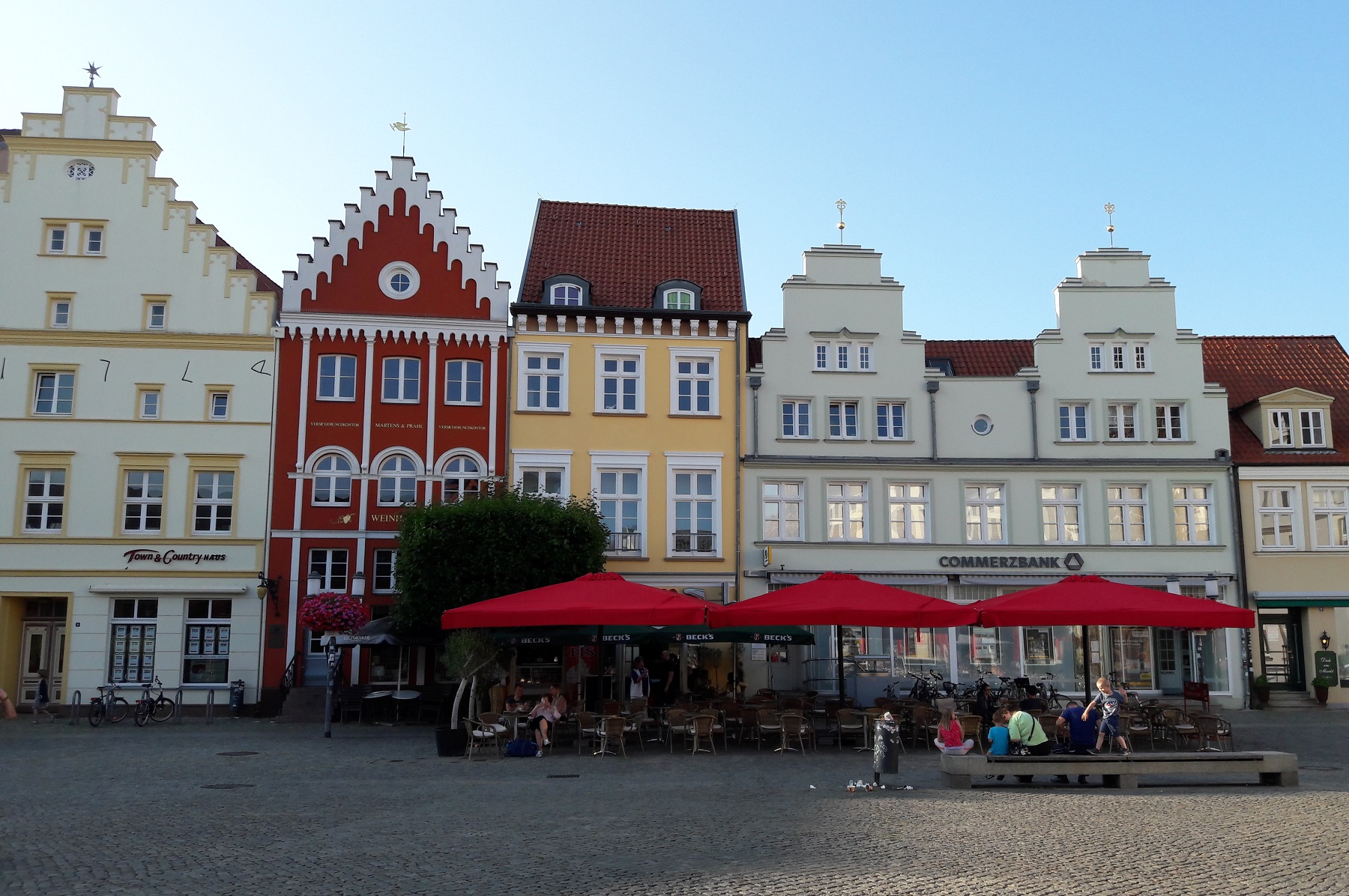
Greifswald’s market square is the center of the city’s medieval town. Almost all around the square you can see beautiful gabled houses and other town houses that are so typical of the German Hanseatic cities and thus also of Greifswald. In season, there is a fantastic atmosphere with the many restaurants for outdoor dining, underlining the square’s popularity among locals and visitors alike.
The square was formed in 1250 as a trading place for Eldena Monastery with the valuable salt, that brought income to the monastery through trade privileges. The Pomeranian Duke gave permission to found the new market place as a competitor to Stralsund, which at this time was part of the Principality of Rügen and thus a rival to Pomerania.
Over time, the typical gabled houses were built to the north, east and south, while the city’s town hall and later also the pharmacy were to the west. The houses with the addresses Markt 11 and Markt 13 have been preserved in the old style and are hightlights. On the south side of the square, gabled houses can no longer be seen, as a post office building (Markt 15-19) replaced the former row of houses here. Since 2014, the large house has functioned as a Stadthaus.
St Nicholas Church is Greifswald’s cathedral and the tallest of the three churches that form the city’s historic skyline. With its 100 meter tower, the church can be seen from a long distance, and the cathedral has also become the city’s landmark. At a height of 60 meters there is a viewing balcony, and from here there is of course a wonderful view of the old town.
The church was built from 1263, and since then it has been changed several times. Historically the tower has been almost 20 meters higher than today, but it partially collapsed during storms twice. The worst incident happened in 1650, when the tower crashed into the church itself, with extensive destruction as a result.
After that accident, funds were collected in the city and neighboring towns, and even the Swedish queen donated money for the reconstruction. The new and current baroque church tower was already completed the following year, and the church itself was subsequently rebuilt. The interior of the church was again changed 1823-1832, and this is the appearance that meets visitors today.
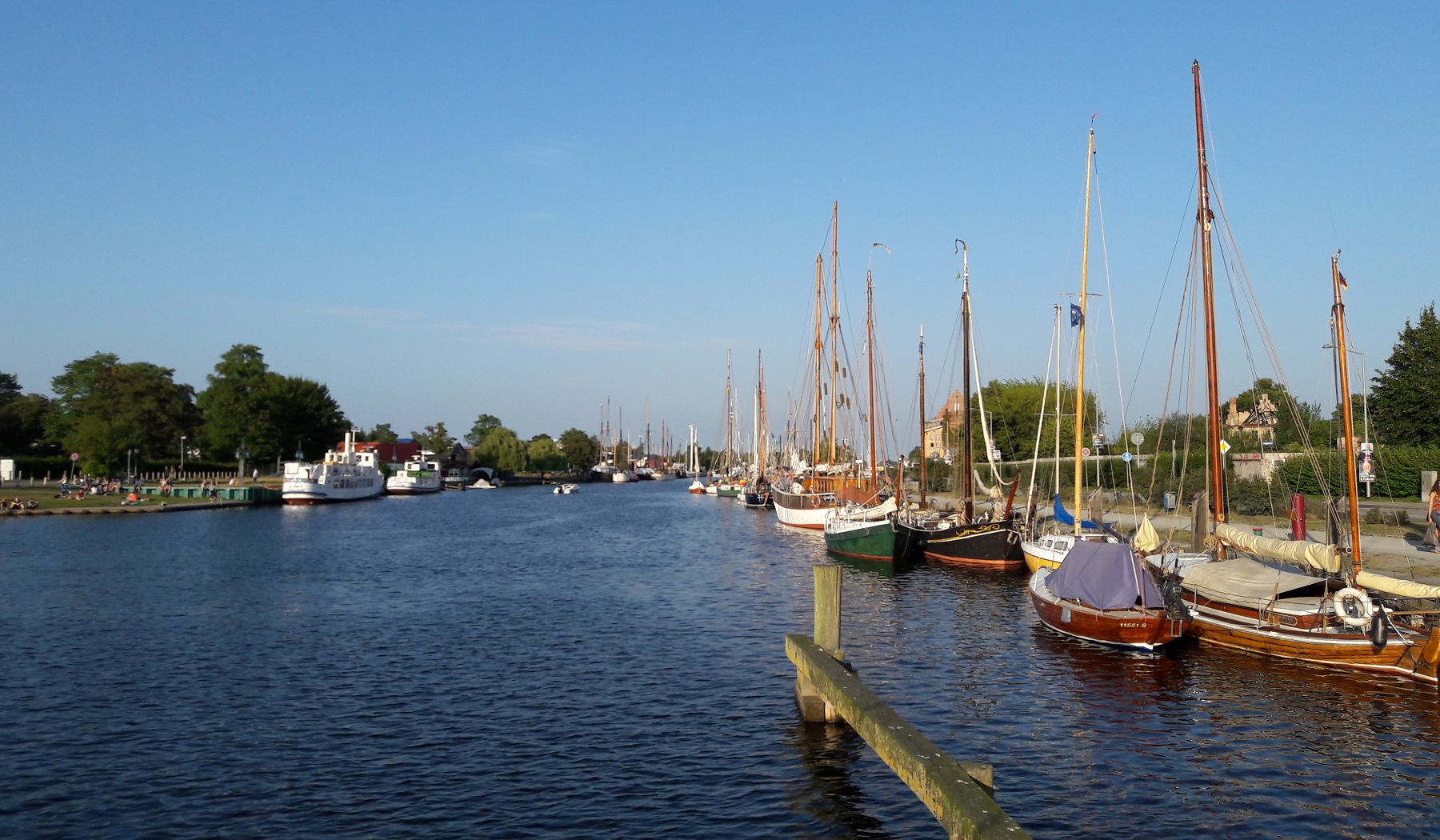
Greifswald’s old trading harbor has now been converted into a museum harbor with a number of old ships, a cozy atmosphere and a history that was one of the reasons for Greifswald’s wealth as a Hanseatic city.
You can go for a walk in the area and simply enjoy the atmosphere and the view of Greifwald’s city centre, which lies immediately south of the harbour. During the season, you can also take a seat at one of the good fish restaurants by the harbor.
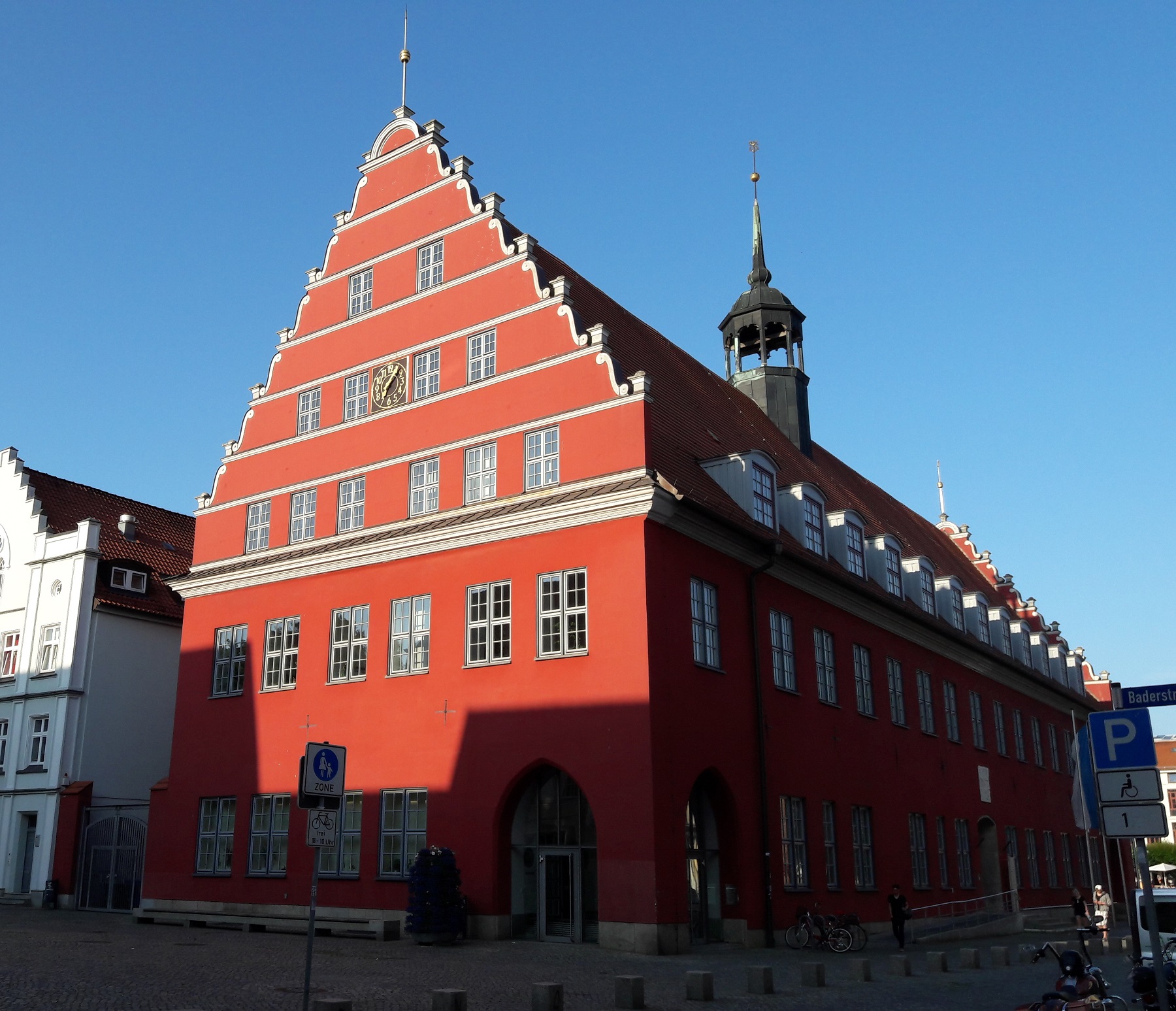
The city hall in Greifswald is the most striking building on the town’s old square and market. It was built in 1369 as a trading house, Kophus, and from 1551 the city government has had its seat here.
The basement of the building is the only part that has been preserved in its original form, while the rest is a beautiful result of later renovations. The town hall was completely destroyed during the great fire in 1713, and it was not rebuilt until 1738, largely with the look you can enjoy today.
Markt 13 is an address on the central market square in Greifswald, and it is occupied by the city’s oldest preserved merchant’s house. It was built in the 13th century and stands today as one of the few houses around Markt in its red bricks with a beautiful gable and facade. You can take a look at the house up close and see the fine construction and architecture.
The history of the Gothic gable house goes back to the time when it was originally probably built with a medieval shield gable. During a rebuild in 1959, a stair gable was built, which was retained during the extensive renovation after 1990. Since 1995, there has been a restaurant in the barrel vault of the basement and on the ground floor.
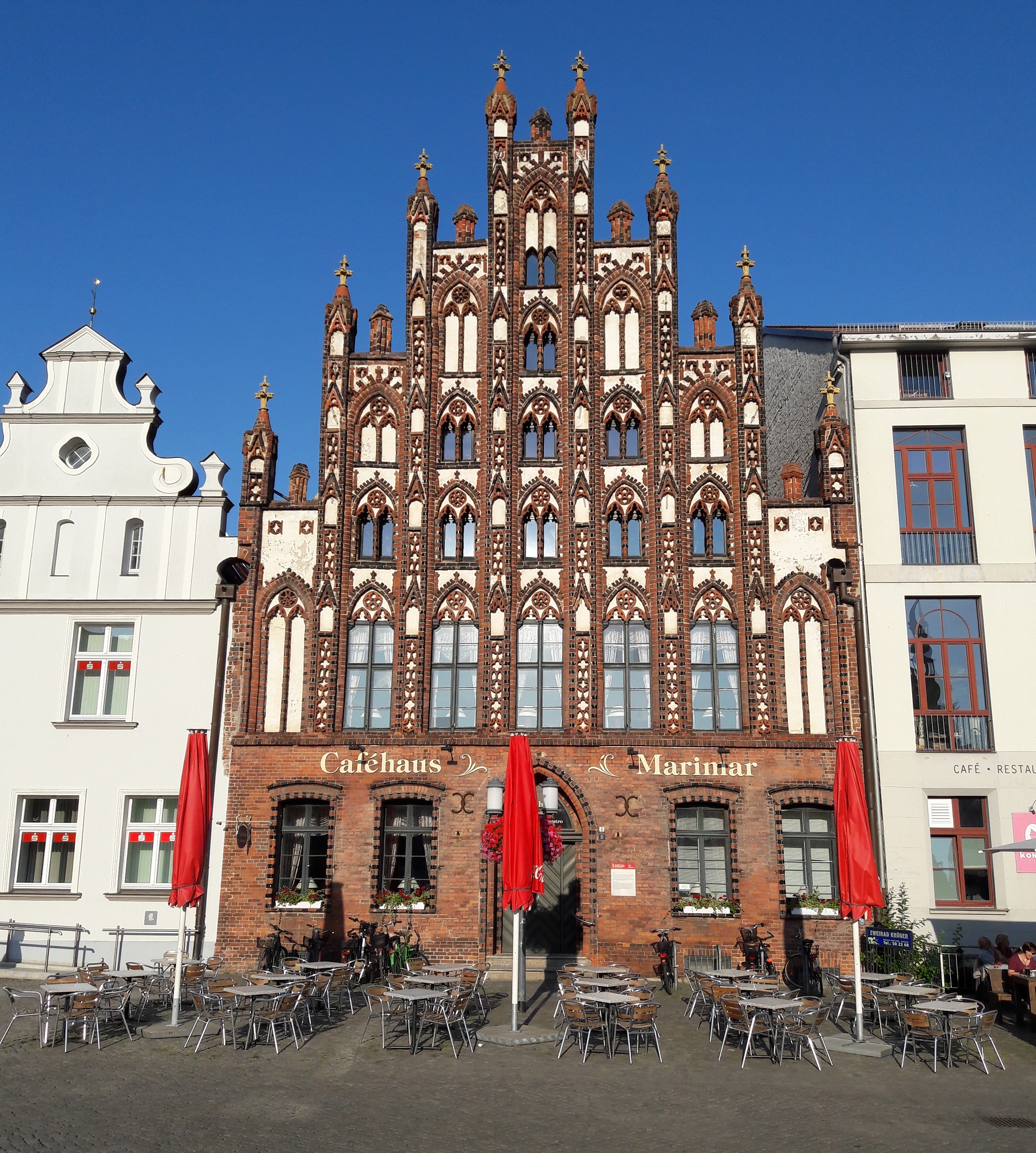
Markt 11 is one of several beautiful houses located at the Marktplatz. It is a gabled house on the eastern side of the square and thus opposite the town hall. The house is a fine example of the North German brick Gothic style seen in many Hanseatic cities.
A house was already built here in the 13th century, and through the 14th and 15th centuries the Rubenow family owned the building. The family provided several mayors to the city, and it was during their time that the house was rebuilt with the current facade; it happened at the beginning of the 15th century. However, the facade was partially rebuilt in a style true to the Gothic in the 1850s.
Today there is a café in Markt 11, but it has had several other functions. In 1945 it became the seat of the local department of the Soviet Army, and in the GDR era the Socialist Unity Party, SED, had a local representation here.
This is the Pomeranian Museum, housed in a classicist main building. The museum depicts the region of Pomerania within, among other things, historical events, geology and art.
The museum traverses Pomerania in an exciting way, and the museum gardens are also worth a trip. The painting collection of the museum contains many works by locals, not least the famous citizen Caspar David Friedrich, and international artists such as Frans Hals and van Gogh.
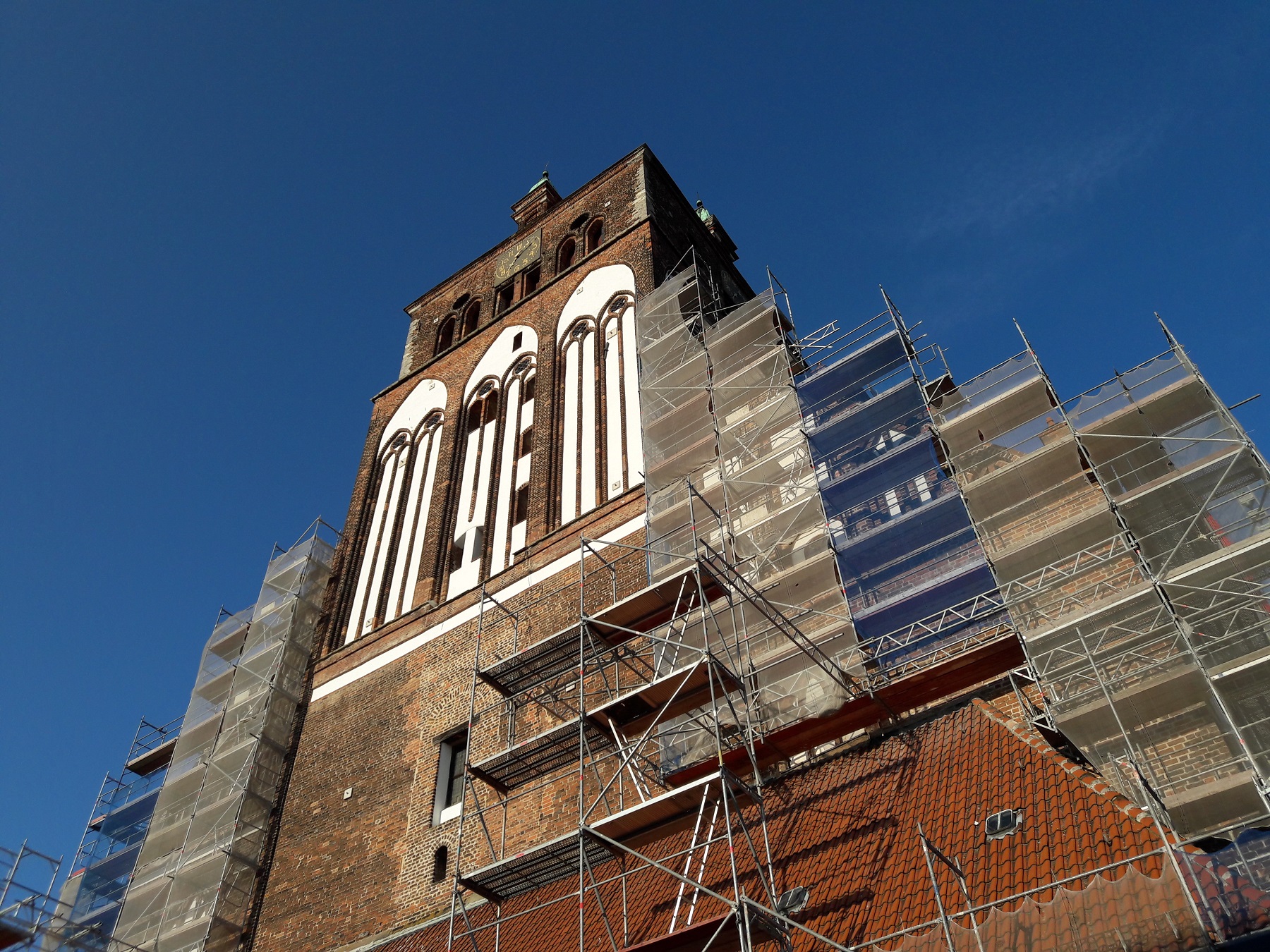
Marienkirche is a brick church and is also one of Greifswald’s three large and majestic churches. It was built from 1250 to the beginning of the 1300s, when it was completed in its original appearance. During the following centuries, the church was extended to a length of 67 meters and with an impressive gabled roof, and the church belongs to one of the finest examples of the typical North German brick Gothic in the area.
A few characteristics from this time and building style are that the church was built as a three-aisled building and without a choir. This gives Marienkirche a rather compact exterior, which has fostered the nickname Fat Mary/Dicke Marie. The reason is quite visible seen from the central market square.
Inside, a beautiful church interior opens up with 21 meters to the ceiling. In the years 1977-1984, the medieval painting was recreated, and in the southwest part of the church you can see 15th-century frescoes. The pulpit is from 1587 and produced in Rostock.
Socio-Cultural Center St. Spiritus is a venue that regularly offers a number of different events, but it’s also worth just taking a walk to see the idyllic buildings whose history goes back to the 13th century.
St. Spiritus was founded as a hospital and home for the elderly around 1250. Until 1975, the place functioned as a care home, and in recent years it has been set up as a cultural centre.
The cozy half-timbered houses were built in the 17th century, but parts of the medieval buildings have still been preserved. Today, the socio-cultural center of St. Spiritus is also located in several other and newer buildings.
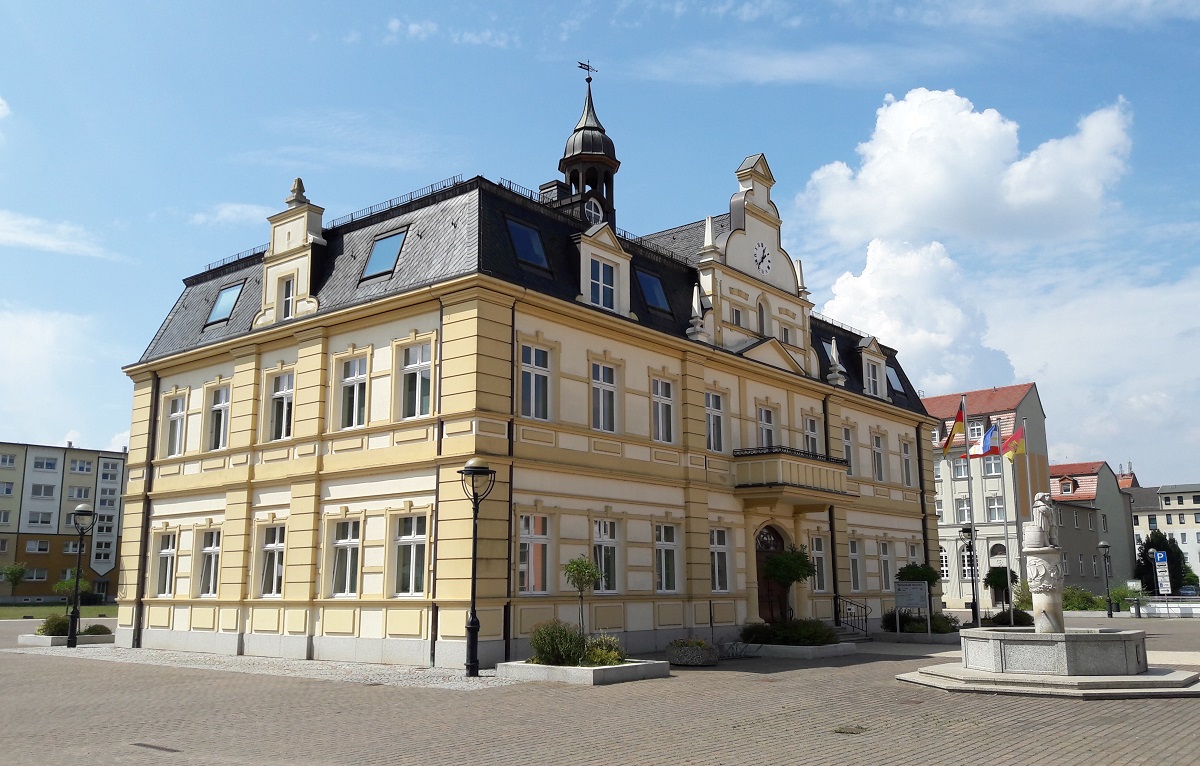
The town of Demmin is one of Mecklenburg-Western Pomerania’s Hanseatic cities, and there are several sights in the town from its history as a fortified trading post. Today, slightly more than 10,000 inhabitants live in Demmin, where Markt forms the central square and town centre.
The square is the city’s marketplace, and it is a good starting point for a stroll in the city. Take a look at the elegant Town Hall before the walk passes the church of St.-Bartholomaei-Kirche and the maritime environment of the city’s once-bustling river port, which has contributed to a great deal of Demmin’s growth.

Anklam is the name of one of the smaller North German Hanseatic cities. It is a small town with an exciting history and fine sights, which can be seen on some lovely walks in the town centre. The best place to start is the main square Markt.
There are some large churches and fine houses in the city streets. The modern history goes back to the 13th century, when trade flourished in the region, and as a visible result, Anklam’s harbor was built. Fish and other goods made the economy grow, and there was corresponding growth in the city.
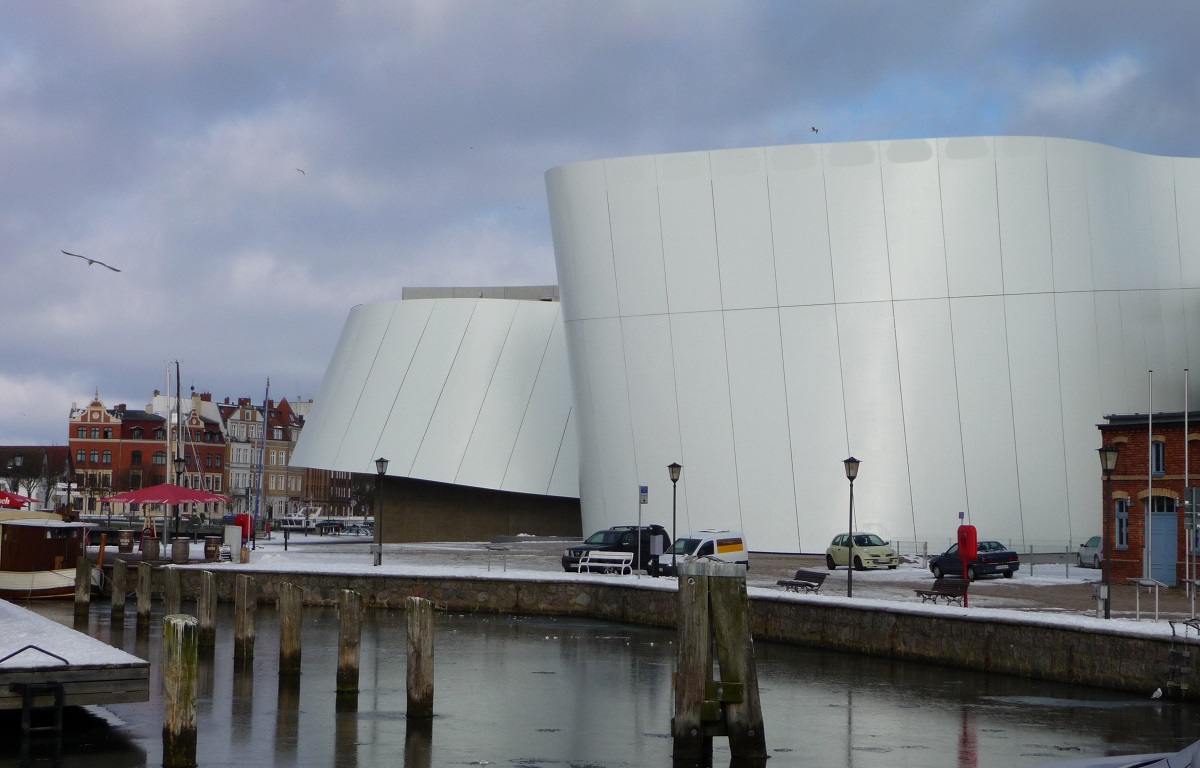
Stralsund is a Hanseatic city and one of the region’s larger cities with a cozy old quarter with many attractions. Stralsund’s rich history as a flourishing Hanseatic city can be seen everywhere. Merchant buildings line the streets between the city’s three large churches and other public buildings that were constructed as symbols of the city’s wealth in the medieval Hanseatic period.
The many small streets are atmospheric as if from a bygone era, and you quickly discover why the city center has made it onto UNESCO’s list of world cultural heritage. Squares and the area by the water are other very lively places where larger events often take place.
Stralsund’s location with water on all sides offers opportunities for many wonderful activities, either directly on the water or at one of the city’s distinguished maritime museums with the modern aquarium, Ozeaneum, as the spearhead.
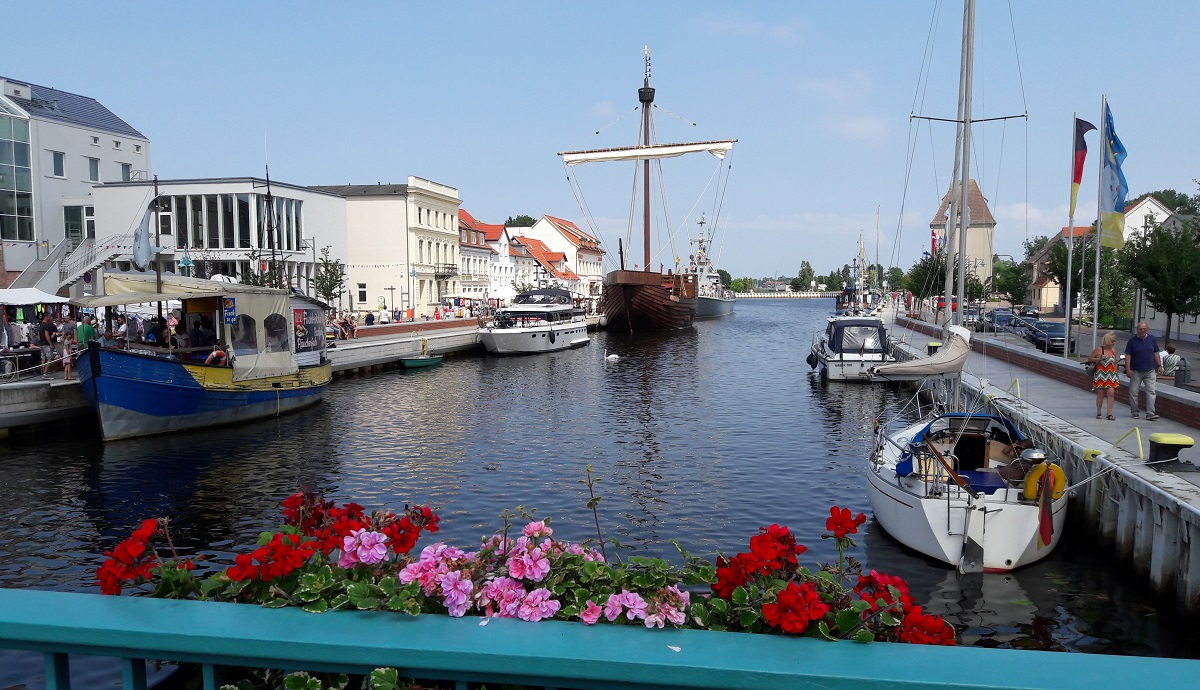
Ueckermünde is a harbor town at the mouth of the river Uecker, and the combination of the maritime with a very pleasant town center makes a trip here a pleasant experience in northeastern Germany.
Historically, Ueckermünde was first mentioned in 1178 and it was a fishing town. In the following centuries, the city grew due to trade and its favorable location on the Uecker, and several larger buildings were constructed like the fortified castle that the dukes of Pomerania had built, churches and fortifications.
Today, many people visit Ueckermünde to take a walk around the charming harbor along the Uecker (Altes Bollwerk, Neues Bollwerk), which is close to the old town. Here is a market and several different options for sailing trips or visits to ships during the season.
However, you should include a trip in the city center northwest of the harbour. Here you can see the preserved parts of the ducal palace (Am Rathaus) from the 1540s, which is today the seat of the city’s administration, and the Marienkirche church (Ueckerstraße 86), which is particularly worth seeing.
Marienkirche in its current version was built in the years 1752-1766 in baroque and rococo architecture; however, with a neo-Gothic tower from 1866. It is the interior of the church that is something special. The interior with balconies and the painted flat wooden ceiling create a special space and atmosphere.
Finally, you can walk about a hundred meters further north-west from the church, where the town square named Markt is located. Markt is surrounded by a number of fine buildings, and there is outdoor seating at the square during the season and a fountain.
The Historisch-Technisches Museum Peenemünde is a museum that was established in 1991 in the former power plant building of the city of Peenemünde. The museum’s primary focus is the German rocket tests and construction that took place around Peenemünde in the period 1936-1945. It was here that Wernher von Braun headed the Nazi rocket program, probably best known for the V1 and V2 rockets.
Wernher von Braun experimented with rockets for many years, and after the end of World War II he continued to work for the United States. His efforts and knowledge ended up being the Saturn V rockets that carried American astronauts into space and to the Moon.
The test facilities at Peenemünde were made possible in 1936 when the Ministry of Aviation in Germany bought the northern part of the island of Usedom from the town of Wolgast for 750,000 reichsmarks. After this, an extensive complex of buildings was built, where rockets and so on were tested. Peenemünde was bombed several times during World War II, with the first raid on the 17th and 18th August 1943.
At the museum, there are also other depictions and objects exhibited than von Braun’s rockets. These include, for example, a corvette from the GDR’s Volksmarine, Russian MIG aircraft and railway equipment. All in all, the place is an experience for both those interested in history and technology.
Lomonossowallee 58
moewencenter.de
Rigaer Straße 9, Greifswald
oez-greifswald.com
Lange Straße
Markt, Lange Straße, Schuhhagen, Knopfstraße
HanseDom
Grünhufer Bogen 18-20, Stralsund
hansedom.de
Heimattierpark
Anlagen 3, Greifswald
tierpark-greifswald.de
Ozeaneum
Hafenstraße 11, Stralsund
ozeaneum.de
The university town of Greifswald is one of Mecklenburg-West Pomerania’s easternmost Hanseatic cities. The town has got its first part of its name from the Pomeranian griff, which is also depicted in the city’s coat of arms.
Founded in the late 1100s, the monastery of Eldena, which is now considered a ruin to the east of the city, also became the starting point for the city’s real urbanization, with Greifswald’s first explosive growth following its founding in the first half of the 13th century. Among other things, the site at the mouth of the Ryck River became a free port, and Duke Wartislaw III guaranteed compensation for any losses to pirates. In 1278, the city was first mentioned as a Hanseatic city.
In the 1300s, Mecklenburg wanted dominion over the area, but among other things by forming alliances with the neighboring towns of Anklam, Demmin and Stralsund and with the help of the Danish king, the Mecklenburgs were kept at a distance. The same federation later formed a common front against pirates.
In 1452, the Pomeranian Duke granted Greifswald far-reaching trade rights, the so-called “golden privileges,” and that was the start of the city’s heyday. Only four years later, Pommerns was founded at the time the only university in Greifswald.
The 30-year war ended the golden age. The city capitulated to the Imperial troops under General Wallenstein in 1627, and it became the start of a period of forced labor. The later plague epidemic only made matters worse, and the city was partially depopulated.
In 1631, the Swedish troops, under King Gustav II Adolf, stood before Greifswald’s defense, and after a short time they had to surrender. The next 184 years came to be under Swedish rule, though with extensive freedom and independence and with significant Swedish church and court authorities in the city. First, at the Vienna Congress in 1815, the city and the Swedish possessions in Pomerania became Prussian. Before then, however, the 18th century had been a tough time for the city, which was ravaged by major fires in 1713 and 1736 as well as destruction following a gunpowder explosion in 1758.
During the 19th century, the highway from Berlin to Stralsund came through Greifswald and in 1863 the railroad was to become economically important. Railway workshops became the most important industry in the Greifswald, and the railway first included various smaller industries. In the economic crisis of the 1920s, for example, the railway workshops closed down and this led to high unemployment. During World War II, there was a large military garrison in the city, which, however, escaped unspoiled through the end of the war. The city commander surrendered Greifswald to Russian troops without a fight on April 30, 1945.
After World War II, Greifswald was part of the GDR, and the city was rapidly developed through the construction of a number of elementary buildings, the so-called Plattenbau, which also led to a severe renovation of some historic buildings. Since the 1980s, the city has been restored to radiate a glorious past.
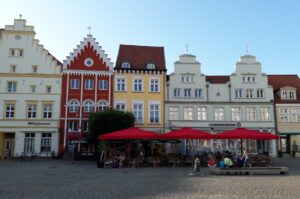
Greifswald, GermanyOverview of Greifswald
Greifswald is a Hanseatic city on the river Ryck, and it is a cozy city with everything that belongs to the character of a Northern German city with roots in the Baltic Sea trade. Beautiful buildings, impressive churches, a central market square and an elegant city hall are just some of the highlights.
Compared to other North German Hanseatic cities, Greifswald is a relatively small town, and it provides the opportunity to easily experience the city on foot. It is not far between the sights, where St. Nicholas Cathedral, the Market Square and the Museum Harbor are good choices for a walk.
Greifswald is not the only Hanseatic city in the region, so there are nice options for day trips, i.e. to Anklam and Demmin, but also to the larger city of Stralsund. You can also enjoy the lovely beaches on the Baltic Sea as well as some museums and cozy towns.
About the Whitehorse travel guide
Contents: Tours in the city + tours in the surrounding area
Published: Released soon
Author: Stig Albeck
Publisher: Vamados.com
Language: English
About the travel guide
The Whitehorse travel guide gives you an overview of the sights and activities of the Canadian city. Read about top sights and other sights, and get a tour guide with tour suggestions and detailed descriptions of all the city’s most important churches, monuments, mansions, museums, etc.
Whitehorse is waiting for you, and at vamados.com you can also find cheap flights and great deals on hotels for your trip. You just select your travel dates and then you get flight and accommodation suggestions in and around the city.
Read more about Whitehorse and Canada
Canada Travel Guide: https://vamados.com/canada
City tourism: https://visitwhite-horse.ca
Main Page: https://www.vamados.com/
Buy the travel guide
Click the “Add to Cart” button to purchase the travel guide. After that you will come to the payment, where you enter the purchase and payment information. Upon payment of the travel guide, you will immediately receive a receipt with a link to download your purchase. You can download the travel guide immediately or use the download link in the email later.
Use the travel guide
When you buy the travel guide to Whitehorse you get the book online so you can have it on your phone, tablet or computer – and of course you can choose to print it. Use the maps and tour suggestions and you will have a good and content-rich journey.


The city hall in Greifswald is the most striking building on the town’s old square and market. It was built in 1369 as a trading house, Kophus, and from 1551 the city government has had its seat here.
The basement of the building is the only part that has been preserved in its original form, while the rest is a beautiful result of later renovations. The town hall was completely destroyed during the great fire in 1713, and it was not rebuilt until 1738, largely with the look you can enjoy today.
Markt 13 is an address on the central market square in Greifswald, and it is occupied by the city’s oldest preserved merchant’s house. It was built in the 13th century and stands today as one of the few houses around Markt in its red bricks with a beautiful gable and facade. You can take a look at the house up close and see the fine construction and architecture.
The history of the Gothic gable house goes back to the time when it was originally probably built with a medieval shield gable. During a rebuild in 1959, a stair gable was built, which was retained during the extensive renovation after 1990. Since 1995, there has been a restaurant in the barrel vault of the basement and on the ground floor.

Markt 11 is one of several beautiful houses located at the Marktplatz. It is a gabled house on the eastern side of the square and thus opposite the town hall. The house is a fine example of the North German brick Gothic style seen in many Hanseatic cities.
A house was already built here in the 13th century, and through the 14th and 15th centuries the Rubenow family owned the building. The family provided several mayors to the city, and it was during their time that the house was rebuilt with the current facade; it happened at the beginning of the 15th century. However, the facade was partially rebuilt in a style true to the Gothic in the 1850s.
Today there is a café in Markt 11, but it has had several other functions. In 1945 it became the seat of the local department of the Soviet Army, and in the GDR era the Socialist Unity Party, SED, had a local representation here.
This is the Pomeranian Museum, housed in a classicist main building. The museum depicts the region of Pomerania within, among other things, historical events, geology and art.
The museum traverses Pomerania in an exciting way, and the museum gardens are also worth a trip. The painting collection of the museum contains many works by locals, not least the famous citizen Caspar David Friedrich, and international artists such as Frans Hals and van Gogh.

Marienkirche is a brick church and is also one of Greifswald’s three large and majestic churches. It was built from 1250 to the beginning of the 1300s, when it was completed in its original appearance. During the following centuries, the church was extended to a length of 67 meters and with an impressive gabled roof, and the church belongs to one of the finest examples of the typical North German brick Gothic in the area.
A few characteristics from this time and building style are that the church was built as a three-aisled building and without a choir. This gives Marienkirche a rather compact exterior, which has fostered the nickname Fat Mary/Dicke Marie. The reason is quite visible seen from the central market square.
Inside, a beautiful church interior opens up with 21 meters to the ceiling. In the years 1977-1984, the medieval painting was recreated, and in the southwest part of the church you can see 15th-century frescoes. The pulpit is from 1587 and produced in Rostock.
Socio-Cultural Center St. Spiritus is a venue that regularly offers a number of different events, but it’s also worth just taking a walk to see the idyllic buildings whose history goes back to the 13th century.
St. Spiritus was founded as a hospital and home for the elderly around 1250. Until 1975, the place functioned as a care home, and in recent years it has been set up as a cultural centre.
The cozy half-timbered houses were built in the 17th century, but parts of the medieval buildings have still been preserved. Today, the socio-cultural center of St. Spiritus is also located in several other and newer buildings.
Similar to Greifswald Travel Guide
